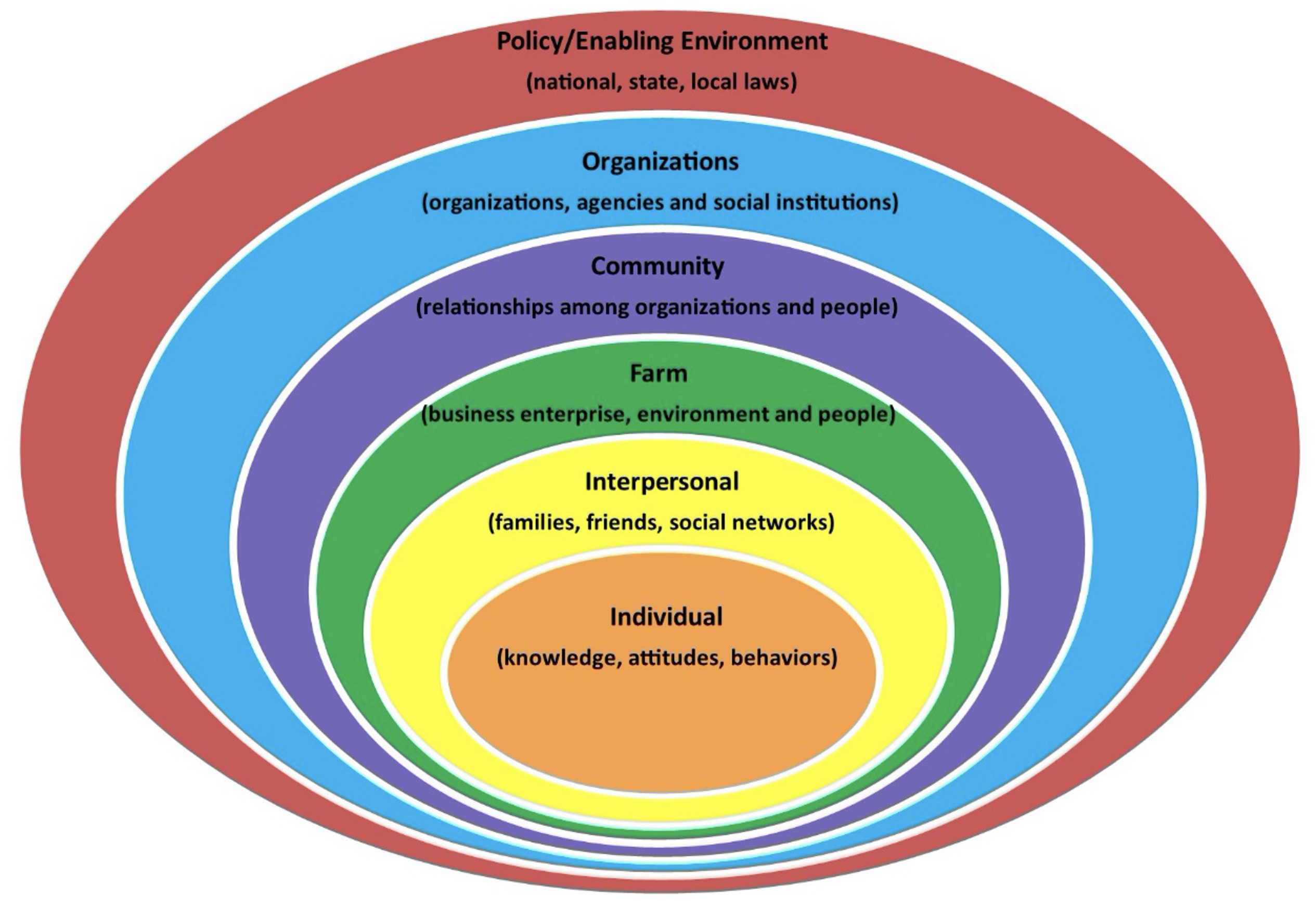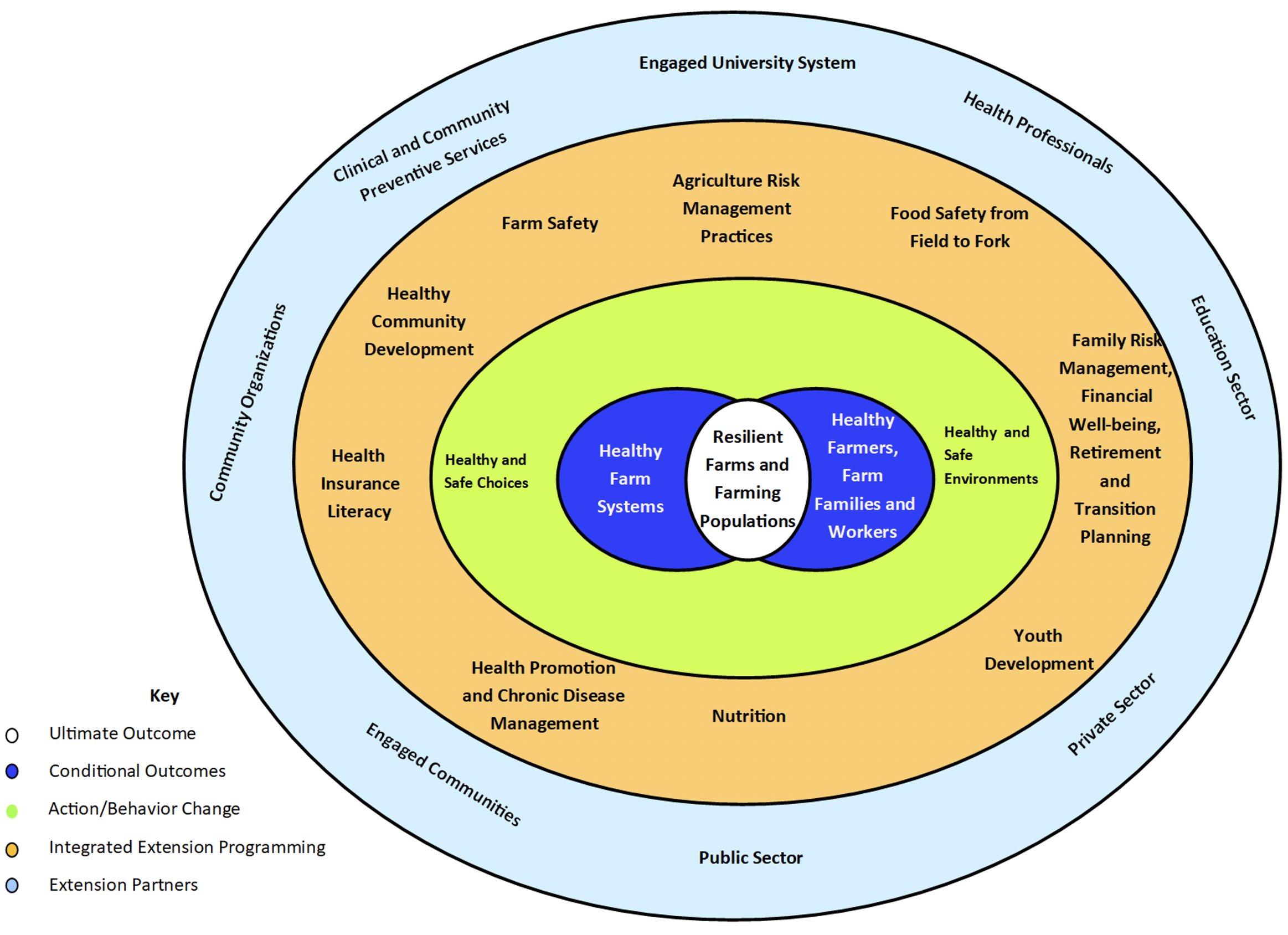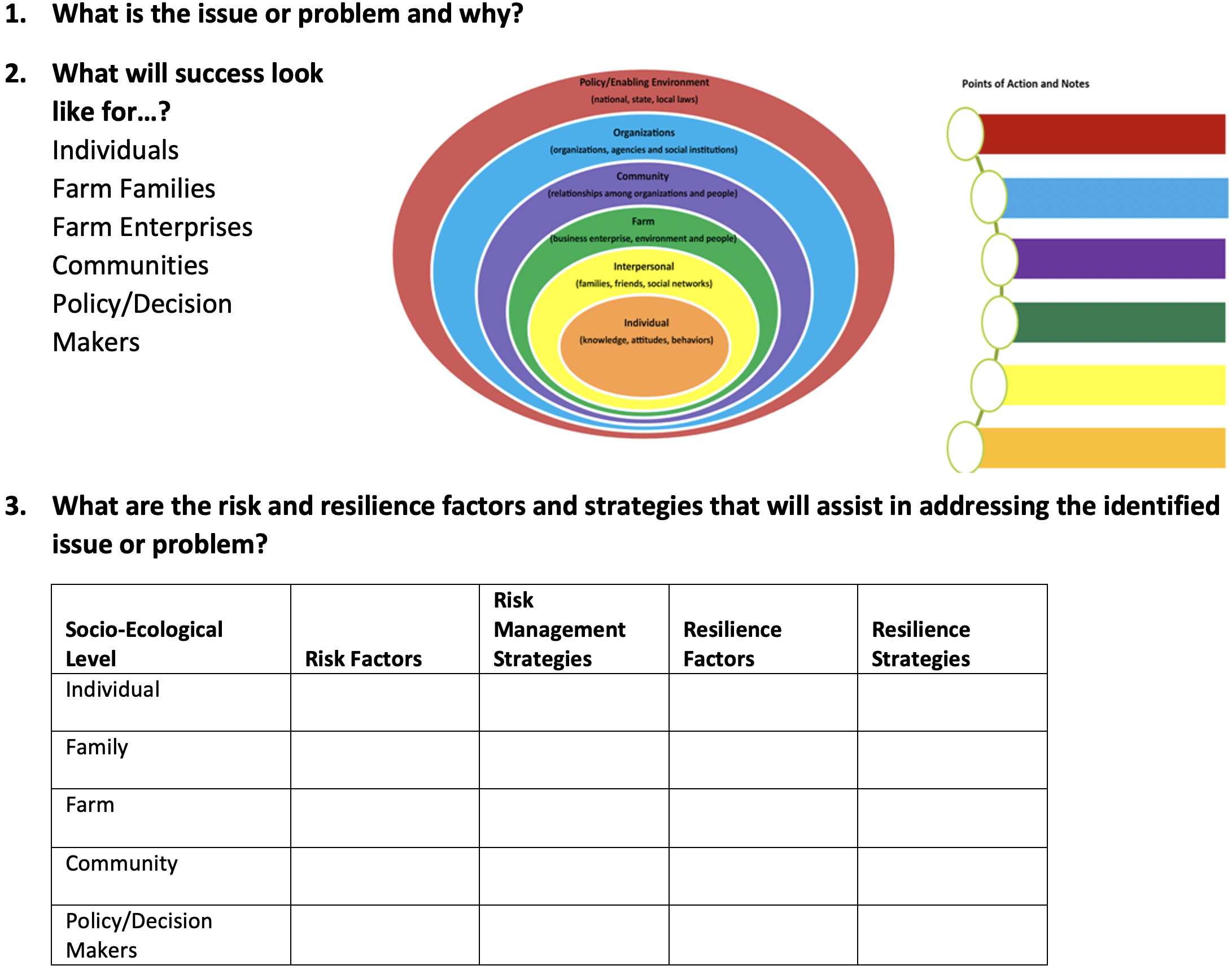 |
October 2020
|
October 2020 // Volume 58 // Number 5 // Tools of the Trade // v58-5tt1
Extension Programming Resource for Building Farm and Farm Family Resilience
Abstract
Farms and farm families experience stress due to the interconnectedness between healthy farm businesses and healthy family members. The resource Farm and Farm Family Risk and Resilience Framework: A Guide for Extension Educational Programming supports Extension educators in providing programming for the farming population. The guide includes a 96-article literature review, a farm and farm family risk and resilience framework, logic models, assessment and teaching tools, and a program planning tool. The guide can help Extension educators assimilate programming approaches and content to reduce risk, build resilience, and strengthen systems.
Introduction
Farms and farm families experience stress due to the interconnectedness between healthy farm businesses and healthy family members. Both ordinary and extraordinary stressors, and the ability to respond appropriately, affect financial, physical, and mental health. Farming is one of the most physically risky occupations (Centers for Disease Control and Prevention, 2018), and suicide rates among farmers are twice that of the general population (Peterson et al., 2018). Between 2013 and 2019, farmers were dealing with a 50% loss of net farm income and a 30% increase in debt (Implementing the Agriculture Improvement Act, 2019). Moreover, farms, farm families, and supporting businesses expect losses for 2020 due to the coronavirus pandemic. Educators have compared the current situation to the farm crisis that occurred in the 1980s (Schulman & Armstrong, 1990). COVID-19, however, adds another farm and farm family stressor to existing market and financial crises for a large segment of farming enterprises.
To support Extension educators in providing programming for the farming population, Bonnie Braun and Maria Pippidis created Farm and Farm Family Risk and Resilience Framework: A Guide for Extension Educational Programming. This guide includes a 96-article literature review, a farm and farm family risk and resilience framework, logic models, assessment and teaching tools, and a program planning tool. The guide's authors reviewed 15 years of literature examining risk management and resilience concepts used in agriculture, community development, health, and family science. Based on the review, they developed a framework for exploring risk and resilience using a socio-ecological model.
Resilience, as defined in the guide, is "capital available to individuals, families, communities, and businesses to respond to demands and challenges of change" (Braun & Pippidis, 2020, p. 13). Resilience is necessary to respond to ordinary and extraordinary stressors and to recover and thrive. Ordinary stressors include balancing a farm business and personal lives, dealing with health and health insurance issues, and managing finances of both farm and family. Extraordinary stressors include unusual weather patterns, low commodity prices, trade issues, changing regulations, and, now, coronavirus.
The impacts of stressors include inhibited decision making, physical and mental health problems, substance abuse, delay of health care, and, potentially, loss of the farm. Negative impacts threaten thriving farms and families and reinforce the need for Extension educators to teach about reducing risk while building resilience.
To test validity, Extension educators and researchers, representing family resource management, rural society, agriculture risk management, health and nutrition, mental health/stress management, rural health, and human development, reviewed the guide for science-based content, accuracy, and effectiveness. Ten others who participated in an eXtension learning circle also reviewed the guide.
To test the guide's content and potential utility, we taught an eXtension learning circle series in 2019. Fifteen Extension educators consistently participated in the four-part series. Jesse Ketterman evaluated the series using pre- and postprogram survey tools at the beginning and end of the series. Analysis indicated that 44% of participants increased knowledge and confidence regarding use of the farm and farm family risk and resilience framework. There was a 22% increase in the extent to which participants agreed with the statement "Achieving resilient farms must go beyond teaching how to manage stress." In addition, 75% of participants indicated that they accomplished what they needed to from attending the learning circle.
Frameworks
The guide authors created the farm and farm family risk and resilience socio-ecological model (Figure 1) as a visual organizing framework. The model adds value by embedding the farm between individual and interpersonal environments and community, organizational, and policy environments. It reinforces the importance of educators going beyond a specific subject, such as stress management focused on individuals, to implementing a holistic, integrated approach. This framework incorporates reinforcement from the Centers for Disease Control and Prevention regarding application of a systems-level approach to change (Holt-Lunstad et al., 2017).
Figure 1.
Farm and Farm Family Risk and Resilience Socio-Ecological Model

Note. From Farm and Farm Family Risk and Resilience: A Guide for Extension Educational Programming, by B. Braun and M. Pippidis, 2020, University of Maryland Extension and University of Delaware Cooperative Extension. (https://www.udel.edu/content/dam/udelImages/canr/pdfs/extension/economic-personal-development/Farm-and-Farm-Family-Risk-and-Resilience-Guide-1-17-20.pdf)
The guide authors adapted the Cooperative Extension National Framework for Health and Wellness (Braun et al., 2014; Rodgers & Braun, 2015) for a second visual. The resulting framework—integrated risk and resilience Extension framework for health and wellness of farms and farming populations—incorporates conditional outcomes, actions/behavior change, integrated Extension programming, and partners. The model, illustrated in Figure 2, highlights the complex relationships between systems, choice making, environments, Extension disciplines, and partners.
Figure 2.
Integrated Risk and Resilience Extension Framework for Health and Wellness of Farms and Farming Populations

Note. From Farm and Farm Family Risk and Resilience: A Guide for Extension Educational Programming, by B. Braun and M. Pippidis, 2020, University of Maryland Extension and University of Delaware Cooperative Extension. (https://www.udel.edu/content/dam/udelImages/canr/pdfs/extension/economic-personal-development/Farm-and-Farm-Family-Risk-and-Resilience-Guide-1-17-20.pdf)
The guide includes two change models and four resilience models from health, human science, and business to answer the question of what might produce effective change. Based on these models are logic models within the guide that address programming for (a) farms and farm families, (b) professionals, and (c) stakeholders. Each logic model begins with a situation statement specific for that audience. Extension educators can use the logic models to identify evaluation strategies at the onset of program development, hone the problem or issue, identify key partners, develop content and delivery methods that match goals, and create realistic programmatic timelines.
Implementation Tools
The guide includes a program planning worksheet tool that infuses the socio-ecological model and logic models into decision making. It allows planners to identify the problem(s) or issue(s); define success; specify risk and resilience factors; identify outcomes, indicators, tools, and partners; provide a timetable; and specify responsibilities. It incorporates the intended audience(s) according to the socio-ecological model. The tool comprises a "who, what, and how" format. A visual is shown in Figure 3.
Figure 3.
Farm and Farm Family Risk and Resilience Extension Program Planning Worksheet

Note. From Farm and Farm Family Risk and Resilience: A Guide for Extension Educational Programming, by B. Braun and M. Pippidis, 2020, University of Maryland Extension and University of Delaware Cooperative Extension. (https://www.udel.edu/content/dam/udelImages/canr/pdfs/extension/economic-personal-development/Farm-and-Farm-Family-Risk-and-Resilience-Guide-1-17-20.pdf)
In addition, the guide includes information about assessment and teaching tools developed by its authors and other professionals. These tools are organized in three categories: (a) health and well-being; (b) financial management; and (c) personal, family, and farm resilience. Aligned with the logic models within each of the categories are tools for farm families, professionals, and key stakeholders. In total, there are nine assessment tools and 50 programmatic tools.
Discussion
Farms and farm families, professionals, and stakeholders need guidance for using integrated approaches based in theory that create multilevel interventions to improve systems in which farms operate. The guide helps Extension educators assimilate programming approaches and content to reduce risk, build resilience, and strengthen those systems—keys to thriving farms and farming communities.
The guide is available at https://www.udel.edu/content/dam/udelImages/canr/pdfs/extension/economic-personal-development/Farm-and-Farm-Family-Risk-and-Resilience-Guide-1-17-20.pdf. Tools referenced in the guide are linked to from the Farm and Farm Family Risk and Resilience Toolkit section at https://www.udel.edu/academics/colleges/canr/cooperative-extension/personal-economic-development/agribusiness/.
Author Note
We would like to thank Lynn Little for editing our article. Also, we sincerely appreciate all the professionals who provided input into the guide.
Correspondence concerning this article should be addressed to Jesse Ketterman. Email: jketterm@umd.edu
References
Braun, B., & Pippidis, M. (2020). Farm and farm family risk and resilience: A guide for Extension educational programming. University of Maryland Extension and University of Delaware Cooperative Extension. https://www.udel.edu/content/dam/udelImages/canr/pdfs/extension/economic-personal-development/Farm-and-Farm-Family-Risk-and-Resilience-Guide-1-17-20.pdf
Braun, B., Bruns, K., Cronk, L., Fox, L. K., Koukel, S., LeMenestrel, S., Lord, L. M., Reeves, C., Rennekamp, R., Rice, C., Rodgers, M., Samuel, J., Vail, A., & Warren, T. (2014). Cooperative Extension's national framework for health and wellness. Association of Public and Land-Grant Colleges, Extension Committee on Organization and Policy. https://www.aplu.org/members/commissions/food-environment-and-renewable-resources/CFERR_Library/national-framework-for-health-and-wellness/file
Centers for Disease Control and Prevention. (2018). Agricultural safety. https://www.cdc.gov/niosh/topics/aginjury/
Holt-Lunstad, J., Roble, T. F., & Sbarra, D. A. (2017). Advancing social connections as a public health priority in the United States. American Psychologist, 72(6), 517–530.
Implementing the Agriculture Improvement Act of 2018, U.S. Senate Committee on Agriculture, Nutrition, Forestry, 115th Cong. (2019) (testimony of Sonny Perdue, Secretary, USDA).
Peterson, C., Stone, D. M., Marsh, S. M., Schumacher, P. K., Tiesman, H. M., McIntosh, W. L., Lokey, C. N., Trudeau, A-R. T., Bartholow, B., & Luo, F. (2018). Suicide rates by major occupational group—17 states, 2012 and 2015. Morbidity and Mortality Weekly Report, 67(45), 1253–1260. http://dx.doi.org/10.15585/mmwr.mm6745a1external icon
Rodgers, M., & Braun, B. (2015). Strategic directions for Extension health and wellness programs. Journal of Extension, 53(3), Article v53-3tt1. https://joe.org/joe/2015june/tt1.php
Schulman, M., & Armstrong, P. (1990). Targeting farmers for stress reduction. Journal of Extension, 28(2), Article 2FEA2. https://www.joe.org/joe/1990summer/a2.php




